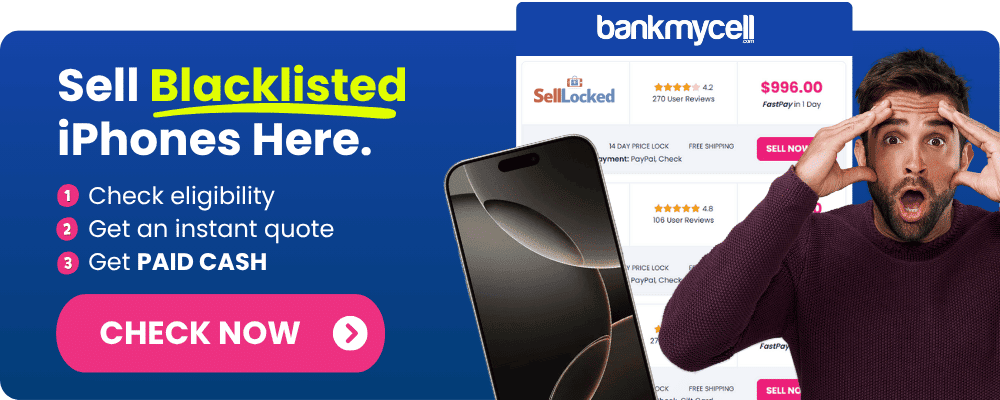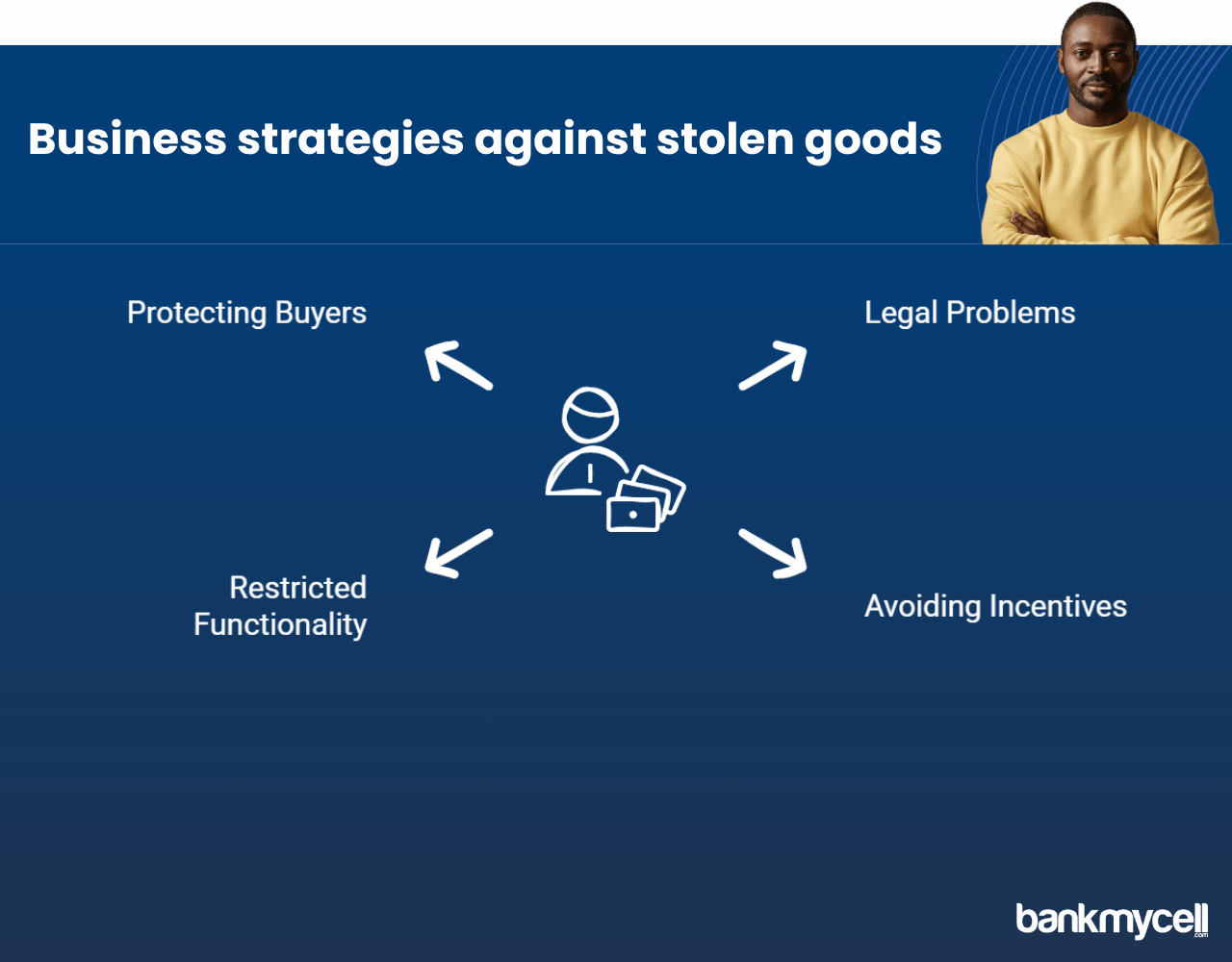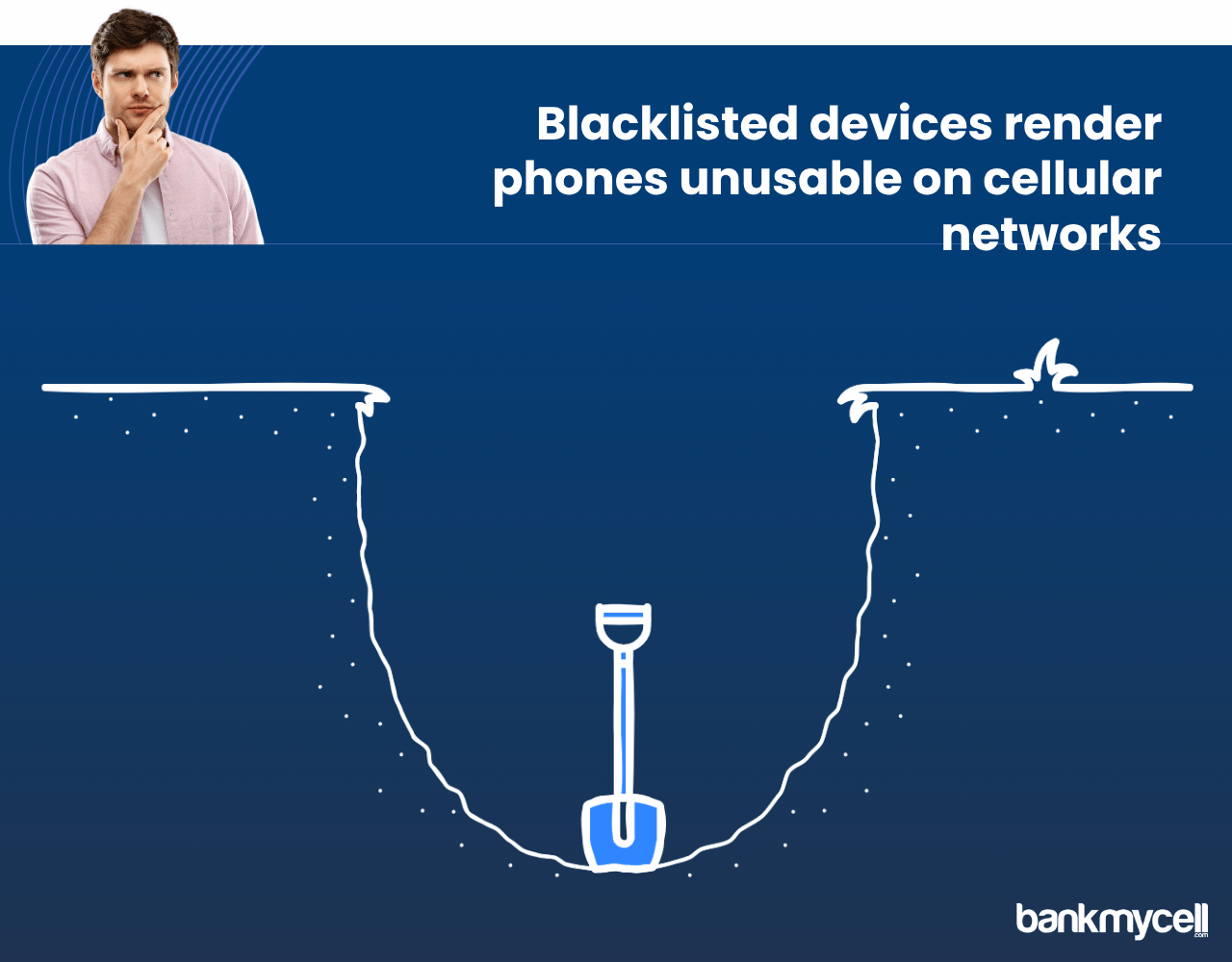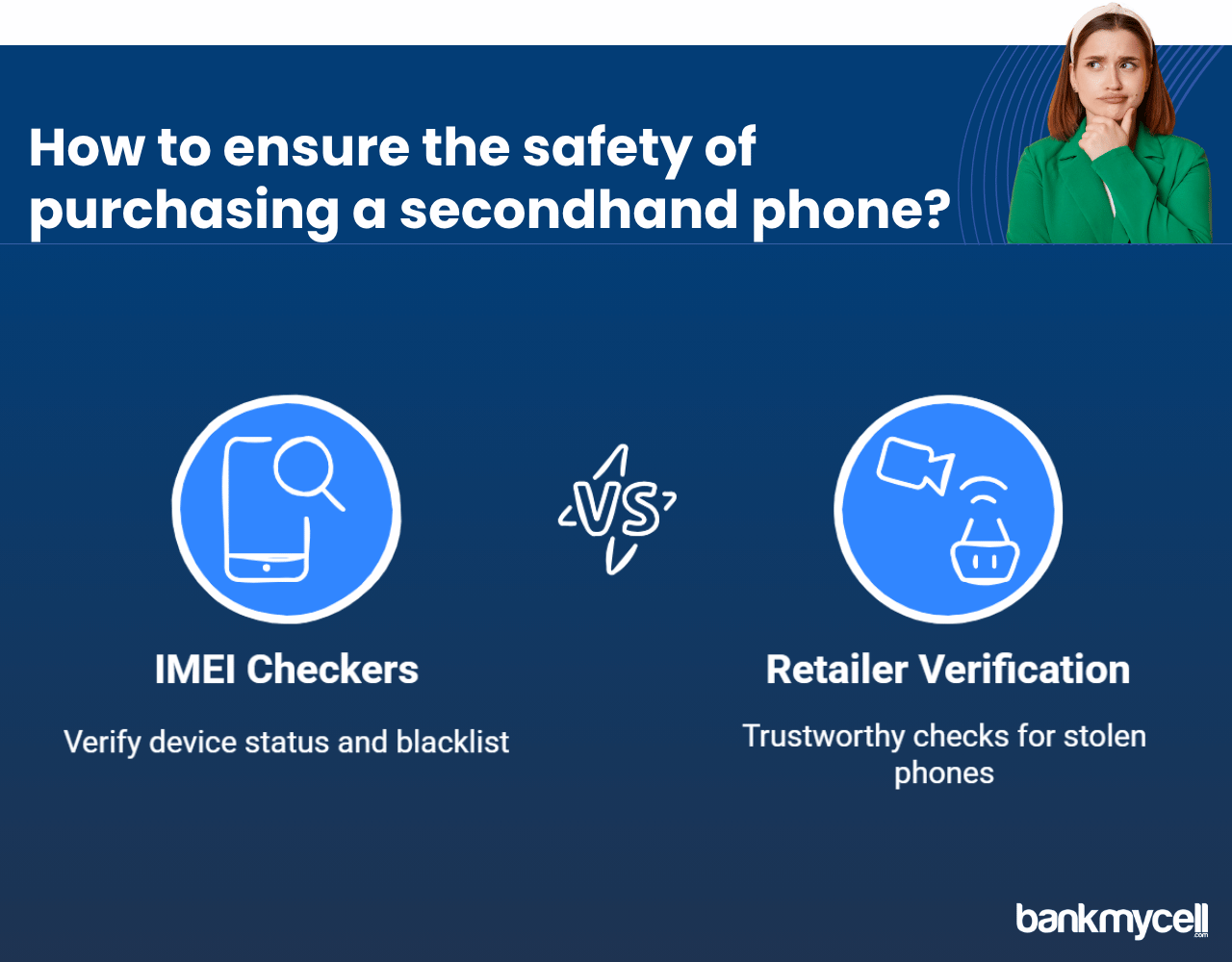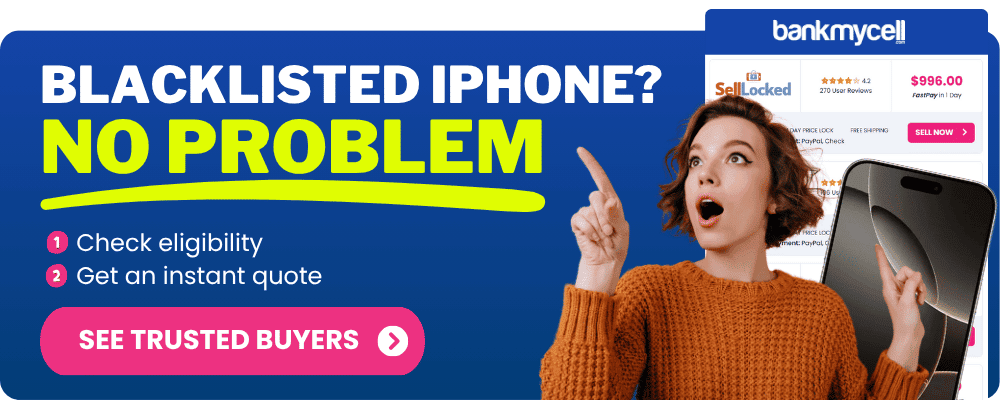Can I Trade in a Blacklisted Phone? What iPhone Owners Need to Know
60-Second Summary
T-Mobile, Verizon and other retailers along with Apple Trade In won’t accept blacklisted phones. The reason behind this is that blacklisted phones might be stolen. Not just this, if a phone is blacklisted, the person who has lost the phone will not be able to use it. It can be determined if your phone is blacklisted or not in a database which is shared between the carriers and is available by searching your phone’s 15-digit IMEI.
Insights
1. Reasons for Denial of Trade-ins:
- Such phones will not work when connected to the network.
- The carriers do not want the legal liability of having stolen phones in their possession.
- They can be sold again but as blacklisted devices, so it cannot be sold at the right price
- The user should confirm his device’s status through IMEI verification techniques instead of assuming the condition
2. Options for Trade-in or Sell are Few:
- Sales services which deal with blacklisted devices are available but will pay up to 20% less of the original device’s price.
- Selling the phone for parts can be considered, which usually fetch 10-30% of the original phone’s value. But the price at which the device can be sold depends on the condition of the blacklisted phone and some authorized shops also offer this facility.
- BankMyCell has such services that can help in selling blacklisted IMEI phone with proper legal formalities.
3. Possibilities for Blacklisted Phones to Sell or Donate:
- Repair programs of electronics like Best Buy and Apple take every device so these stores can be visited and the phone can be traded in.
- Phone with a blacklisted IMEI number can be used by a single person only so this device can be used as a Wi-Fi device only.
- Donate it to college students, that these students can use for their lessons
How to avoid blacklisted device future
Always check the IMEI status before buying any used device and if it is in good standing with the provider, it will help in future trade-in or resale of the device.
Bottom Line: The users can’t trade-in blacklisted devices with services like T-Mobile, Verizon and Apple’s Trade In but still there are some alternative options available like specialized buyback companies but the value that can be attained will be comparatively low than the actual price. Sadly, you can’t get fair value from selling your blacklisted iPhone through conventional channels. BankMyCell takes in Blacklisted iPhones in any condition while making sure all legal compliance requirements are met. From verified stores and with free shipping, BankMyCell can help get competitive buyback quotes so turning a blacklisted device into cash to trade in on a new iPhone is better than settling for minimal pay elsewhere.
Disclaimer: You can sell blacklisted iPhones as long as you’re the legal owner. For example, if you bought the iPhone from a store or a person and it’s not found or stolen, you can sell it. If you’re unsure, check with the store you choose, and they will guide you.
| TODAY'S BEST BLACKLISTED iPHONE TRADE-IN CASH OFFERS | |||
|---|---|---|---|
| Device | Blacklisted | ||
| iPhone 16e | $360.00 | Compare | |
| iPhone 16 Pro Max | $1045.00 | Compare | |
| iPhone 16 Pro | $870.00 | Compare | |
| iPhone 16 Plus | $420.00 | Compare | |
| iPhone 16 | $395.00 | Compare | |
| iPhone 15 Pro Max | $730.00 | Compare | |
| iPhone 15 Pro | $650.00 | Compare | |
| iPhone 15 Plus | $335.00 | Compare | |
| iPhone 15 | $345.00 | Compare | |
| iPhone 14 Pro Max | $570.00 | Compare | |
| iPhone 14 Pro | $400.00 | Compare | |
| iPhone 14 Plus | $265.00 | Compare | |
| iPhone 14 | $235.00 | Compare | |
| iPhone 13 Pro Max | $280.00 | Compare | |
| iPhone 13 Pro | $220.00 | Compare | |
| iPhone 13 Mini | $115.00 | Compare | |
| iPhone 13 | $140.00 | Compare | |
| iPhone 12 Pro Max | $150.00 | Compare | |
| iPhone 12 Pro | $140.00 | Compare | |
| iPhone 12 Mini | $115.00 | Compare | |
| iPhone 12 | $100.00 | Compare | |
| iPhone 11 Pro Max | $115.00 | Compare | |
| iPhone 11 Pro | $115.00 | Compare | |
| iPhone 11 | $105.00 | Compare | |
| * Best market prices updated December 26th 2025 | |||

Data Source: BankMyCell compares over 100,000+ quotes and customer reviews from 20+ trusted buyback stores every 15 minutes via our data feeds, making us America’s #1 time-saving trade-in supermarket.
You want to exchange a blacklisted phone or iPhone but then find out that it has been flagged because of a bad IMEI or bad ESN.
The realization that your device has been flagged becomes frustrating when you bought it used without knowing about its negative status. You might have bought the item secondhand without knowing its previous owner had reported it stolen or lost, or your payment delinquency to your carrier could have caused an unpaid balance.
Here’s the problem:
The trade-in value of blacklisted iPhones and phones with bad ESNs faces significant restrictions which create confusion for owners during the selling process.
And that’s not all…
Buyback services from legitimate companies immediately discard phones with blacklists or activation locks that will remain unable to operate on cellular networks.
The majority of trade-in programs do not accept blacklisted iPhones and phones because these devices show up in a shared database maintained by major carriers due to being reported lost, stolen or having unpaid financial obligations.
The status of an iPhone as blacklisted arises from either a report of theft or loss by the owner or from existing financial obligations that remain unpaid. The unique 15-digit IMEI number of blacklisted devices becomes a shared database entry which major carriers like T-Mobile and numerous retailers can view.
This means:
- Major cellular networks will not activate any blacklisted iPhone or phone.
- Most blacklisted devices encounter global market demand impacts as a result of their limited activation capabilities.
- The device remains severely limited in its capabilities even though it functions as a carrier locked phone.
Think about it:
Is it worth purchasing a phone that fails to establish any connection with cellular networks? Can you still buy a device with certainty when it could be stolen property? Recognized businesses refuse devices with blacklisted IMEI numbers because they recognize the potential problems they pose.
Apple Trade In along with carriers such as Verizon and AT&T plus retailers including Best Buy and GameStop enforce stringent policies that prevent blacklisted devices from being accepted because of carrier-imposed restrictions.
Why Trade-in Programs Have These Policies
Trade-in programs must refuse blacklisted iPhones and phones because multiple crucial factors drive this decision.
- Businesses that handle merchandise which might be stolen face potential legal problems and involvement in criminal activities.
- Businesses avoid offering incentives for stolen devices that get reported to local authorities.
- The severely restricted functionality of blacklisted phones creates significant barriers to selling them at competitive prices.
- Businesses protect buyers from accidental purchases of devices with compromised ESN status.
These policies provide protection for businesses and consumers but they leave owners of blacklisted devices and financed phones with few options to earn more money.
Check if your device has been blacklisted before you try to sell it. BankMyCell provides tools to determine whether your phone is blacklisted and shows you various buyback options to evaluate pricing.
How to Check if Your iPhone is Blacklisted
To determine whether your iPhone is on the blacklist, you need to conduct a check before assuming it’s blacklisted.
It’s crucial to verify your phone’s blacklist status before deciding whether to give up hope on selling it. It’s possible to encounter misleading details about your device’s status.
The most dependable method to confirm blacklist status involves checking the IMEI number or serial number of your device.
The best way to determine if your iPhone is blacklisted is to verify its IMEI number or serial number.
- Retrieve your IMEI by entering #06# or by visiting Settings > General > About on your phone
- You can verify blacklist status by using a free online IMEI checker or reaching out to your carrier directly.
- Many carriers provide IMEI checking tools on their websites which allow you to confirm whether your device is blacklisted.
- For more comprehensive information use third-party dedicated IMEI verification services.
Disclaimer: You can sell blacklisted iPhones as long as you’re the legal owner. For example, if you bought the iPhone from a store or a person and it’s not found or stolen, you can sell it. If you’re unsure, check with the store you choose, and they will guide you.
Contact Your Original Carrier
As the primary owner who has an outstanding balance on your device:
- Reach out to your carrier’s customer service department or get in touch with Apple Support
- Submit your account details together with your device’s IMEI number.
- Inquire from your carrier about the current status of your device and the reasons behind its blacklist designation
- Ask how you can resolve the problem with your device that might be related to unpaid bills on a financed phone.
Limited Options for Blacklisted iPhones and Phones
Although you cannot use regular trade-in programs for your blacklisted phone you still have other potential options.
There are specialized buyback services available for phones that have bad ESN.
Specialized buyback services will sometimes take blacklisted phones and devices with bad ESN but impose substantial restrictions.
- Your blacklisted phone will fetch trade-in value that’s usually 20% or less compared to a clean device.
- These specialized services typically market blacklisted devices as parts or distribute them to international buyers who face different market conditions.
- Before sending a blacklisted phone for sale through a service provider ensure that the service is legitimate.
Parts Value for Blacklisted iPhones
The hardware of a blacklisted iPhone maintains its value independent of its storage capacity.
- The screen, camera, battery and SIM card slot components maintain their resale value
- Certain repair shops and private buyers source blacklisted phones to harvest parts
- Devices are sometimes eligible for minimal reimbursement from independent repair providers.
But here’s the truth:
A blacklisted iPhone will yield far less money than a clean carrier-unlocked phone because you’ll likely receive only 10-30% of the phone’s top dollar selling value.
Looking for options for your problematic iPhone? BankMyCell helps users identify buyback stores that might accept phones with various problems and even blacklisted devices for parts at reasonable rates.
You have multiple ethical options to handle your blacklisted iPhone or phone.
Explore these ethical solutions when traditional trade-in options aren’t available for your device.
Electronics Recycling Programs
Numerous electronics retailers provide recycling programs which accept all types of devices.
- Major retailers such as Best Buy and Apple will recycle phones irrespective of whether they appear on the blacklist.
- Some trade-in programs provide small incentives including gift cards when you purchase phones.
- These programs implement recycling processes to dispose of electronic waste appropriately.
- The recycling process for electronic components minimizes environmental damage and thwarts fraudulent activities.
Repurpose as a Wi-Fi Only Device
An iPhone placed on a blacklist retains its functionality as a Wi-Fi device even without cellular capabilities.
- Transform your blacklisted iPhone into a device exclusively for playing music or gaming
- Configure your new device to operate as a home automation controller.
- Install appropriate applications to transform it into a security camera system
- Use the phone as an emergency backup or while transitioning to a new device.
Donate for Educational Purposes
Numerous educational programs will accept donations of devices no matter what their current carrier status is.
- Educational institutions might use donated phones for instructional purposes to demonstrate phone technology concepts.
- Certain nonprofits refurbish devices and distribute them to needy individuals at discounted prices.
- Technical schools might utilize these devices to teach repair techniques for iPhone models
Avoiding Blacklisted Phones in the Future
Take these steps to avoid this problem next time you buy a used phone.
Always Check Before Buying Used Phones
When purchasing a secondhand iPhone:
- Before purchasing any secondhand phone you need to request the device’s IMEI number.
- Free IMEI checkers help users confirm whether a device is blacklisted and if activation locking remains active.
- Ensure you obtain purchase documentation from the seller or previous owner.
- Look for trustworthy retailers who have verification systems that examine whether phones have been stolen.
Keep Your Own Devices Clean
Maintaining your devices in a non-blacklisted status preserves their resale value.
- Clear any outstanding balances before selling your phone to prevent complications with your carrier.
- Contact your insurance firm immediately for lost or stolen devices and provide them with recovery updates if they are found.
- Maintaining documentation of your purchases and payments ensures you have accurate information.
- Stay in good standing with your carrier by preventing any unpaid balance problems.
Wrapping It Up
Traditional trade-in programs reject blacklisted phones yet alternative solutions exist. Specialized buyback services together with recycling programs offer ethical methods to deal with devices that have been blacklisted or phones with bad ESN.
The guidance provided in this document will enable you to:
- Always confirm your iPhone’s blacklist status before deciding it’s worthless
- Potential alternative channels exist that could increase your options through their value offerings.
- Choose sustainable options whenever you need to recycle.
- Implement measures that will prevent future mishaps while trying to maximize your device’s value.
Preventive measures such as verifying a device’s status before purchasing and maintaining account good standing can help you avoid problems related to blacklisted iPhones or phones with bad IMEI numbers.
Helpful FAQ's
Can a blacklisted iPhone or phone be removed from the blacklist?
A blacklisted iPhone or phone can be removed from the blacklist by its original carrier and usually only under certain conditions.
Only the original carrier that blacklisted a phone can remove it from the blacklist and this usually requires specific conditions to be met. The rightful owner who finds a previously reported lost or stolen phone can request its removal from the blacklist. Clearing unpaid bills on a financed phone can lift its blacklisting status.
Will a factory reset remove blacklisting?
A factory reset will not eliminate blacklisting from your iPhone.
Performing a factory reset does not eliminate blacklisting from your device. The blacklist links directly to the iPhone’s IMEI number found in the International Mobile Equipment Identity database which remains unchangeable through software since it is hardcoded into the device.
Is it possible to use an iPhone that has been blacklisted for any purpose?
A blacklisted iPhone retains functionality when connected to Wi-Fi services only. You can operate the blacklisted iPhone to run apps, play games, listen to music and use any other functions that don’t need cellular connectivity. Wi-Fi-only features will operate correctly despite having a bad ESN.
How much can I get for a blacklisted iPhone sold for parts?
The selling price for a blacklisted iPhone used for parts depends on multiple factors including its model and condition.
The market value depends on the model’s specifications along with its condition and age but generally falls between 10-30% of the non-blacklisted iPhone’s worth. Blacklisted phones in good condition and from newer models achieve higher parts sales values compared to older or damaged devices.
Is it legal to sell a blacklisted iPhone?
Selling a blacklisted iPhone remains legal provided sellers disclose its status and ensure they do not misrepresent the phone as fully functional.
